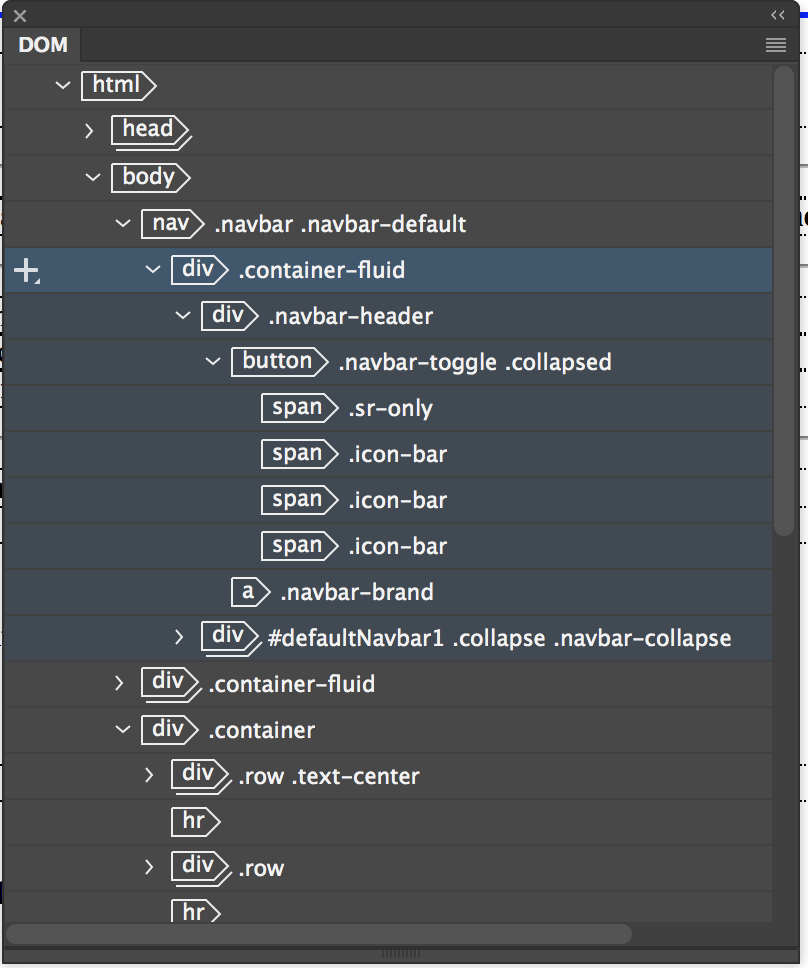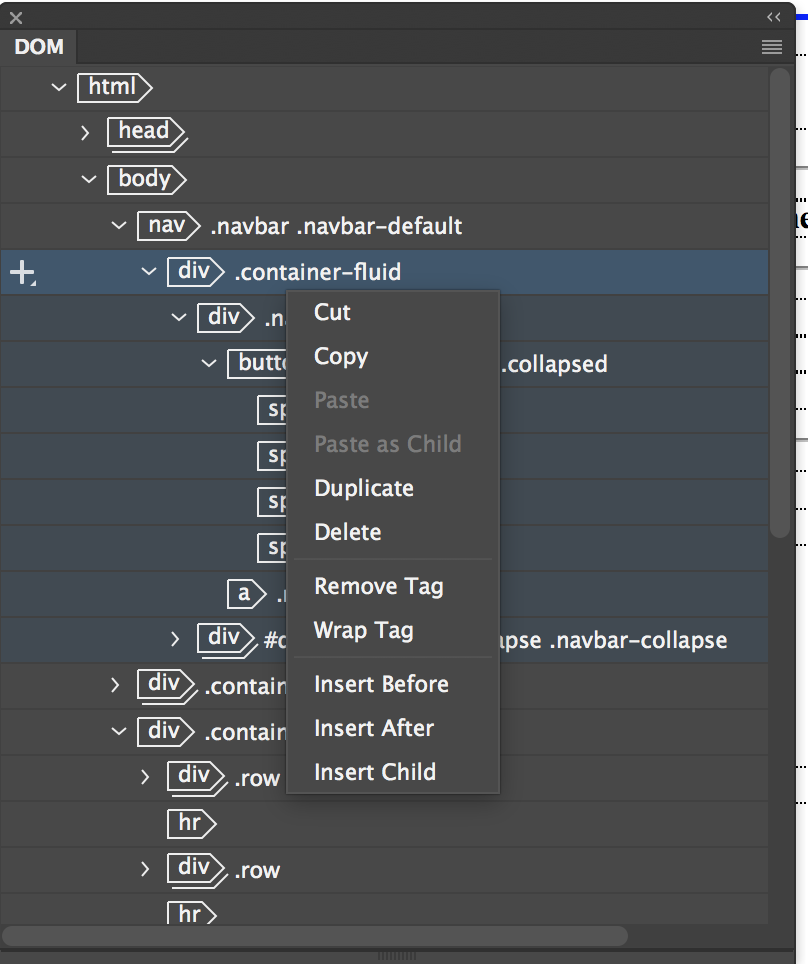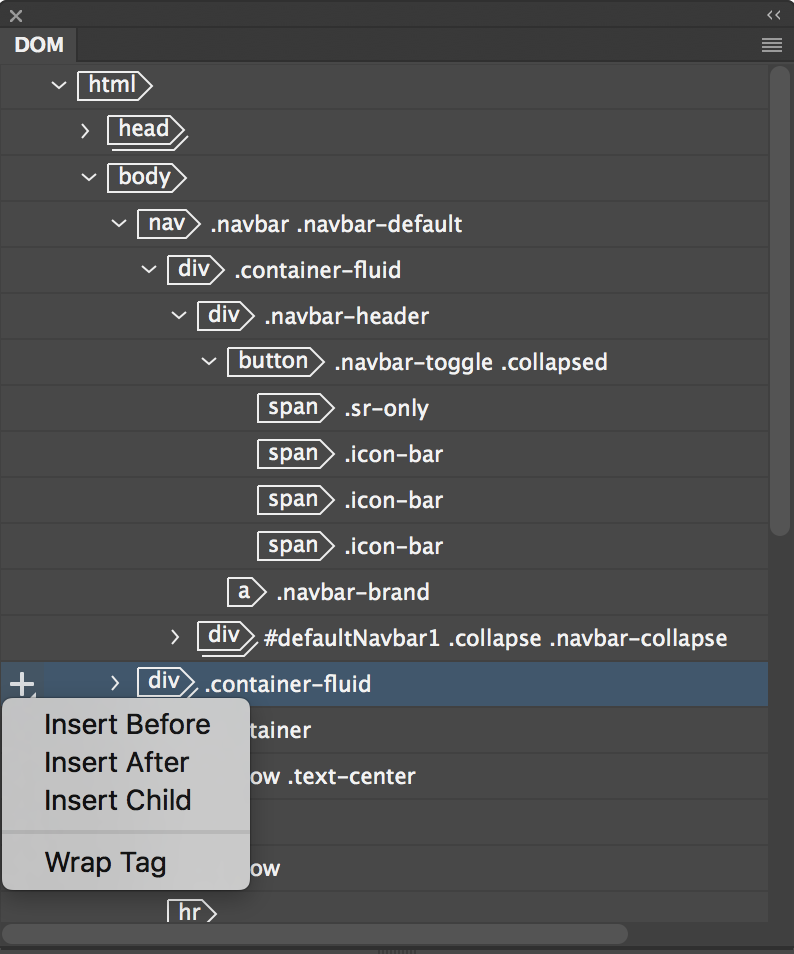Open the required document and then open the DOM panel by selecting Window > DOM.
- Dreamweaver User Guide
- Introduction
- Dreamweaver and Creative Cloud
- Dreamweaver workspaces and views
- Set up sites
- About Dreamweaver sites
- Set up a local version of your site
- Connect to a publishing server
- Set up a testing server
- Import and export Dreamweaver site settings
- Bring existing websites from a remote server to your local site root
- Accessibility features in Dreamweaver
- Advanced settings
- Set site preferences for transferring files
- Specify proxy server settings in Dreamweaver
- Synchronize Dreamweaver settings with Creative Cloud
- Using Git in Dreamweaver
- Manage files
- Create and open files
- Manage files and folders
- Getting and putting files to and from your server
- Check in and check out files
- Synchronize files
- Compare files for differences
- Cloak files and folders in your Dreamweaver site
- Enable Design Notes for Dreamweaver sites
- Preventing potential Gatekeeper exploit
- Layout and design
- CSS
- Understand Cascading Style Sheets
- Laying out pages using CSS Designer
- Using CSS preprocessors in Dreamweaver
- How to set CSS Style preferences in Dreamweaver
- Move CSS rules in Dreamweaver
- Convert inline CSS to a CSS rule in Dreamweaver
- Work with div tags
- Apply gradients to background
- Create and edit CSS3 transition effects in Dreamweaver
- Format code
- Page content and assets
- Set page properties
- Set CSS heading properties and CSS link properties
- Work with text
- Find and replace text, tags, and attributes
- DOM panel
- Edit in Live View
- Encoding documents in Dreamweaver
- Select and view elements in the Document window
- Set text properties in the Property inspector
- Spell check a web page
- Using horizontal rules in Dreamweaver
- Add and modify font combinations in Dreamweaver
- Work with assets
- Insert and update dates in Dreamweaver
- Create and manage favorite assets in Dreamweaver
- Insert and edit images in Dreamweaver
- Add media objects
- Adding videos in Dreamweaver
- Insert HTML5 video
- Insert SWF files
- Add audio effects
- Insert HTML5 audio in Dreamweaver
- Work with library items
- Using Arabic and Hebrew text in Dreamweaver
- Linking and navigation
- jQuery widgets and effects
- Coding websites
- About coding in Dreamweaver
- Coding environment in Dreamweaver
- Set coding preferences
- Customize code coloring
- Write and edit code
- Code hinting and code completion
- Collapse and expand code
- Reuse code with snippets
- Lint code
- Optimize code
- Edit code in Design view
- Work with head content for pages
- Insert server-side includes in Dreamweaver
- Using tag libraries in Dreamweaver
- Importing custom tags into Dreamweaver
- Use JavaScript behaviors (general instructions)
- Apply built-in JavaScript behaviors
- About XML and XSLT
- Perform server-side XSL transformations in Dreamweaver
- Performing client-side XSL transformations in Dreamweaver
- Add character entities for XSLT in Dreamweaver
- Format code
- Cross-product workflows
- Installing and using extensions to Dreamweaver
- In-App updates in Dreamweaver
- Insert Microsoft Office documents in Dreamweaver (Windows only)
- Working with Fireworks and Dreamweaver
- Edit content in Dreamweaver sites using Contribute
- Dreamweaver-Business Catalyst integration
- Create personalized email campaigns
- Templates
- About Dreamweaver templates
- Recognizing templates and template-based documents
- Create a Dreamweaver template
- Create editable regions in templates
- Create repeating regions and tables in Dreamweaver
- Use optional regions in templates
- Define editable tag attributes in Dreamweaver
- How to create nested templates in Dreamweaver
- Edit, update, and delete templates
- Export and import xml content in Dreamweaver
- Apply or remove a template from an existing document
- Edit content in Dreamweaver templates
- Syntax rules for template tags in Dreamweaver
- Set highlighting preferences for template regions
- Benefits of using templates in Dreamweaver
- Mobile and multiscreen
- Dynamic sites, pages and web forms
- Understand web applications
- Set up your computer for application development
- Troubleshoot database connections
- Removing connection scripts in Dreamweaver
- Design dynamic pages
- Dynamic content sources overview
- Define sources of dynamic content
- Add dynamic content to pages
- Changing dynamic content in Dreamweaver
- Display database records
- Provide and troubleshoot live data in Dreamweaver
- Add custom server behaviors in Dreamweaver
- Building forms using Dreamweaver
- Use forms to collect information from users
- Create and enable ColdFusion forms in Dreamweaver
- Create web forms
- Enhanced HTML5 support for form elements
- Develop a form using Dreamweaver
- Building applications visually
- Build master and detail pages in Dreamweaver
- Build search and results pages
- Build a record insert page
- Build an update record page in Dreamweaver
- Building record delete pages in Dreamweaver
- Use ASP commands to modify database in Dreamweaver
- Build a registration page
- Build a login page
- Build a page that only authorized users can access
- Securing folders in Coldfusion using Dreamweaver
- Using ColdFusion components in Dreamweaver
- Test, preview, and publish websites
- Troubleshooting
Learn how to use the DOM panel to edit the HTML structure by mapping elements in Live View or applied selectors in CSS Designer with their HTML markup.
The DOM panel renders an interactive HTML tree for static and dynamic content. This view helps you visually map elements in Live View with their HTML markup and the applied selectors in CSS Designer. You can also make edits to the HTML structure in the DOM panel and see the changes take effect instantly in Live View.
To open the DOM panel, select Window > DOM. You can also use the keyboard keys - Ctrl + / (Win); Cmd + / (Mac) - to open the DOM panel.
When you drag elments to directly insert them in Live View, the </> icon appears before you drop the element. You can click this icon to open the DOM panel and insert the element at the appropriate position in the document structure. For more information, see Insert elements directly in Live View.
The DOM panel displays only static elements in Code or Design view, and both static and dynamic elements in Live view.
In fluid grid documents, the DOM panel only lets you visualize the HTML DOM structure and does not let you edit the HTML structure.
You can edit only the static content in the DOM panel. Read-only or dynamic elements are shown in a darker shade of grey.


You can move around the DOM panel and place it at any convenient location on the user interface. You can also dock the panel along with other panels.
How to use the DOM panel
-
-
Switch to Live view and click the element that you want to inspect or edit.
- The HTML markup of the selected element is highlighted in the DOM panel.
- The applied selector is highlighted in CSS Designer.
- The relevant code is highlighted in the Code view.
- The relevant tag is highlighted (in blue) in Tag Selector.
Alternatively, you can select an HTML element in the DOM panel. When you click any element in the DOM panel:
- Live View scrolls to the corresponding element.
- If Code View is open, the Code View scrolls to the code corresponding to the element.
- CSS Designer (Selectors pane) scrolls to the closest corresponding selector (similar to you clicking the element in Live View).
- The tag is highlighted in the Tag Selector.
This syncing between different views and CSS Designer lets you visualize the HTML markup and styling associated with the selected element at a glance.
-
Proceed to edit the element as required (HTML or CSS editing). For information on using the DOM panel to edit the HTML markup, see Edit HTML structure using the DOM panel. For information on CSS Designer, see Laying out pages using CSS Designer.
Edit HTML structure using the DOM panel
The current selected element on the page is highlighted in the DOM panel. You can navigate to any node or element using the arrow keys.
Keyboard shortcuts:
- Duplicate - Ctrl + D (Win)/ Cmd + D (Mac)
- Delete - Del or Backspace
- Copy - Ctrl + C (Win)/Cmd + C (Mac)
- Paste - Ctrl + V (Win)/Cmd + V (Mac)
- Undo - Ctrl + Z (Win)/Cmd + Z (Mac)
- Redo - Ctrl + Y (Win)/Cmd + Y (Mac)
- To select an element or a node, click the element or node. To expand or collapse an element or a node, click the HTML tag or double-click the selector adjacent to the tag.
- To duplicate an element or a node, right-click the element or the node, and click Duplicate. When you duplicate an element with an ID associated with it, the ID is incremented for the new (duplicate) element.
- To copy an element or a node, right-click the element or the node, and click Copy. If you have copied an element with children, the child elements are also copied.
- To paste an element or a node, click the element or the node under which you want to nest the copied elements. Then, right-click the element or the node and click Paste.
- To paste the copied element as a child of a specific element or node, right-click the element or node (parent), and then click Paste As Child.
- To move or rearrange elements, drag the element to the required location within the DOM panel.
A green line appears to indicate where the dragged element will be positioned. If you drop the element over the element highlighted in gray (reference element), then the dropped element is positioned as the first child of the reference element.
- To delete an element or a node, right-click the element or the node, and click Delete.
You can undo (Ctrl/Cmd + Z) or redo (Ctrl/Cmd + Y) the operations that you perform in the DOM panel.
To perform the above mentioned editing operations on multiple elements, select mutliple elements in the DOM panel:
- Shift + click the required elements for contiguous selection
- Ctrl + click the required elements for non-contiguous selection
Typically, when a page is edited, the Refresh button in the Document toolbar changes to Stop button indicating that the page is reloading. After the page is reloaded, the Refresh button appears again to indicate that the page has completely loaded.


Important: If your page contains JavaScript, the right-click menu in the DOM panel gets displayed for a while and then becomes unavailable. To use the right-click menu, hide the Live View displays (Live View options > Hide Live View Displays), and then disable JavaScript (Live View options > Disable JavaScript).
Edit tags, classes, and IDs in DOM panel
You can edit tags, classes, and IDs by double-clicking them in the DOM panel. You can also add additional classes or IDs by separating them with a space. For tags that are not associated with a class or ID, you can type the name of the class or ID after double-clicking the tag.
Code hints appear as you begin typing the tag, class, or ID name. To narrow down the hints to classes, begin typing with a dot. To see only the IDs in the hints, begin typing with a hash (#).


Insert elements in DOM panel
You can now insert new elements into your web page using the DOM panel in one of the following ways:
- Press the Spacebar or click the insert icon adjacent to the required element in the DOM panel. In the pop-up that appears, click one of the options. To wrap multiple elements with a tag, select the required elements and then choose Wrap Tag from the insert options.


- Click the required element in the Insert panel and drag it to the DOM panel. Live Guides appear to indicate where the element will be inserted. Drop the element at the required location.
When you insert tags using the DOM panel, default (placeholder) text and required attributes for the tags are also inserted:
- When you insert any of the following tags and commit changes, default text is inserted in Code, Live, and Design view:
div, header, nav, aside, article, section, footer, h1-h6, and hgroup - When you insert a table tag and commit the changes, a 3X3 table is inserted.
- When you insert an embed or img tag and commit the changes, the Select File dialog box appears and prompts you to select an appropriate file.
- When you insert a meta tag and commit the changes, the following code is added in Code view: <meta name="" content="">
- When you insert a figure tag and commit the changes, a figure tag with nested figcaption is inserted.
- When you insert a ul or an ol tag and commit the changes, an ol/ul tag with nested li tag is inserted.